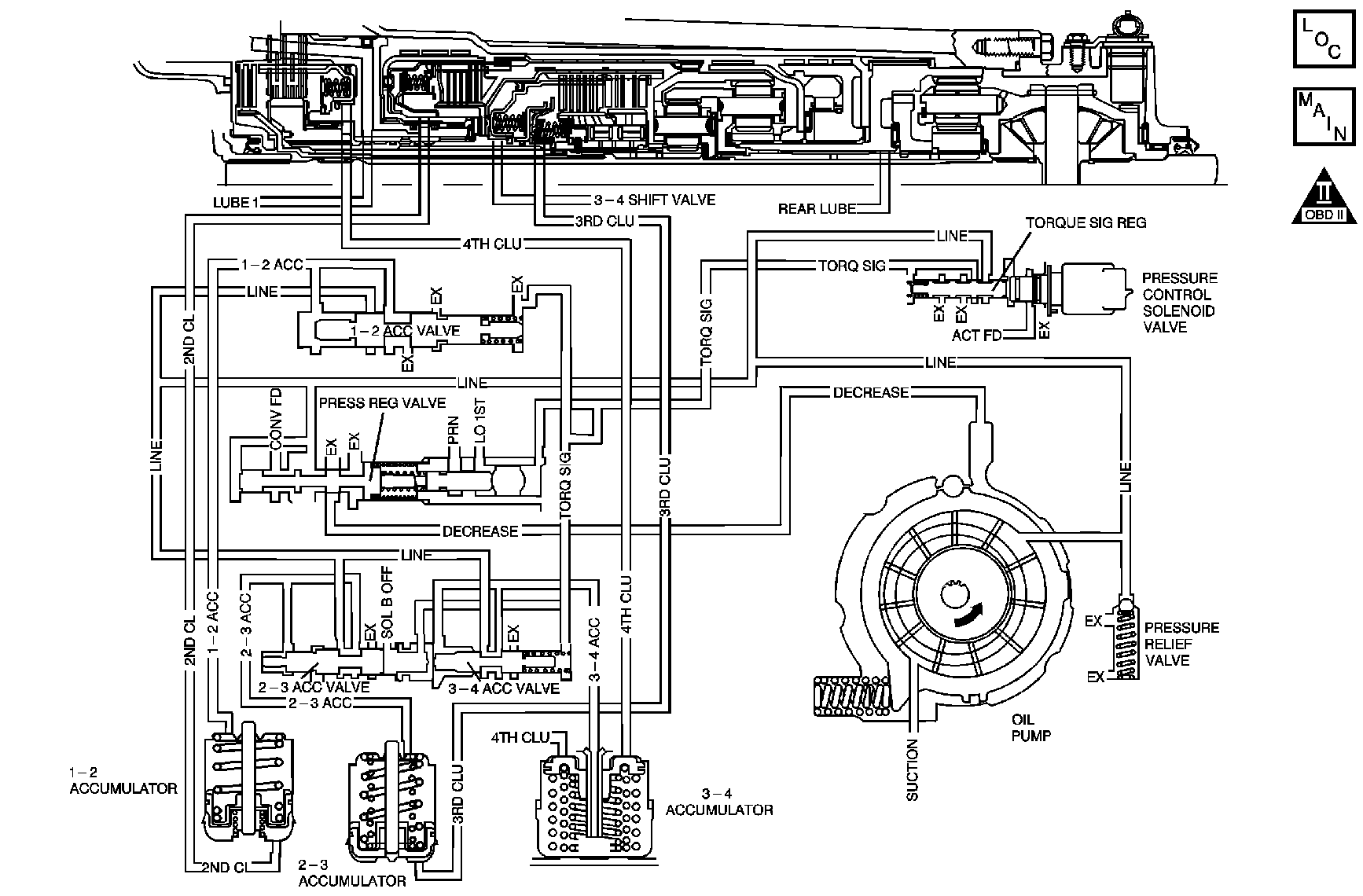DTC P1811 3.5L

Circuit Description
The transmission pressure is modified by an adaptive modifier which controls the shift execution time. This diagnostic tests the time required to accomplish the shift. If the shift takes longer than 0.65 seconds and the adaptive modifier cannot shorten this time, then a counter increases by one.
If the PCM detects a counter value of 2 during one trip, then DTC P1811 sets. DTC P1811 is a type C DTC.
DTC Descriptor
This diagnostic procedure supports the following DTC:
DTC P1811 Maximum Adapt and Long Shift
Conditions for Running the DTC
| • | The shift is adaptable. |
| • | The 1-2, the 2-3 or the 3-4 shift adapt cell has reached its limit. |
Conditions for Setting the DTC
The 1-2, 2-3 or 3-4 shift is longer than 0.65 seconds, twice in one trip.
Action Taken When the DTC Sets
| • | The PCM does not illuminate the malfunction indicator lamp (MIL). |
| • | The PCM commands maximum line pressure. |
| • | The PCM freezes transmission adaptive functions. |
| • | The PCM records the operating conditions when the Conditions for Setting the DTC are met. The PCM stores this information as Failure Records. |
| • | The PCM stores DTC P1811 in PCM history. |
Conditions for Clearing the DTC
| • | A scan tool can clear the DTC. |
| • | The PCM clears the DTC from PCM history if the vehicle completes 40 warm-up cycles without a non-emission-related diagnostic fault occurring. |
| • | The PCM cancels the DTC default actions when the ignition switch is OFF long enough in order to power down the PCM. |
Diagnostic Aids
| • | Ask the customer about possible overloading, exceeding the trailer towing limit, or towing in overdrive. |
| • | Ensure that the current PCM calibration is correct for the final drive ratio. |
Test Description
The numbers below refer to the step numbers on the diagnostic table.
-
This step inspects components that may cause low line pressure.
-
This step inspects or repairs components that may cause a maximum adapt and long 1-2 upshift.
-
This step inspects or repairs components that may cause a maximum adapt and long 2-3 upshift.
-
This step inspects or repairs components that may cause a maximum adapt and long 3-4 upshift.
Step | Action | Value(s) | Yes | No | ||||||||||||||||||||||||||||||||||||
|---|---|---|---|---|---|---|---|---|---|---|---|---|---|---|---|---|---|---|---|---|---|---|---|---|---|---|---|---|---|---|---|---|---|---|---|---|---|---|---|---|
1 | Did you perform the Diagnostic System Check -- Vehicle? | -- | Go to Step 2 | |||||||||||||||||||||||||||||||||||||
2 | Did you perform the Transmission Fluid Checking Procedure? | -- | Go to Step 3 | Go to Transmission Fluid Check | ||||||||||||||||||||||||||||||||||||
3 |
Important: Before clearing the DTCs, use the scan tool in order to record the Failure Records for reference. Using the Clear DTC Information function will erase the stored Failure Records from the PCM. Are any of DTCs P0120, P0220, P0218, P0502, P0503, P0711 or P0712 also set? | -- | Go to Step 4 | Go to Step 5 | ||||||||||||||||||||||||||||||||||||
4 | Diagnose the above DTCs first. Is the diagnosis and repair complete? | -- | Go to Step 14 | -- | ||||||||||||||||||||||||||||||||||||
5 |
Did all the shift times exceed the specified value? | 0.65 seconds | Go to Step 6 | Go to Step 8 | ||||||||||||||||||||||||||||||||||||
6 | Perform the Line Pressure Check Procedure. Refer to the Line Pressure Check . Is the line pressure within specifications? | -- | Go to Diagnostic Aids | Go to Step 7 | ||||||||||||||||||||||||||||||||||||
Inspect the transmission for the following conditions:
Refer to Incorrect Line Pressure . Did you complete the repair? | -- | Go to Step 14 | -- | |||||||||||||||||||||||||||||||||||||
8 | Did the 1-2 shift time exceed the specified value? | 0.65 second | Go to Step 9 | Go to Step 10 | ||||||||||||||||||||||||||||||||||||
Inspect the transmission for the following conditions:
Did you complete the repair? | -- | Go to Step 14 | -- | |||||||||||||||||||||||||||||||||||||
10 | Did the 2-3 shift time exceed the specified value? | 0.65 second | Go to Step 11 | Go to Step 12 | ||||||||||||||||||||||||||||||||||||
Inspect the transmission for the following conditions:
Did you complete the repair? | -- | Go to Step 14 | -- | |||||||||||||||||||||||||||||||||||||
12 | Did the 3-4 shift time exceed the specified value? | 0.65 second | Go to Step 13 | Go to Diagnostic Aids | ||||||||||||||||||||||||||||||||||||
Inspect the transmission for the following conditions:
Did you complete the repair? | -- | Go to Step 14 | -- | |||||||||||||||||||||||||||||||||||||
14 |
Refer to Transmission Fluid Check . Important: The Reset Transmission Adapts function will clear all adapt cells. This may affect transmission performance. The PCM will update the transmission adapt cell values as the vehicle is driven. Did you complete the above procedure? | -- | Go to Step 15 | -- | ||||||||||||||||||||||||||||||||||||
15 | Perform the following procedure in order to verify the repair:
Was each shift time less than 0.65 second? | -- | Go to Step 16 | Go to Step 2 | ||||||||||||||||||||||||||||||||||||
16 | With a scan tool, observe the stored information, capture info and DTC info. Does the scan tool display any DTCs that you have not diagnosed? | -- | System OK |
